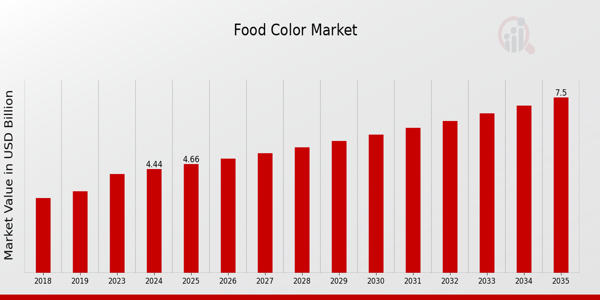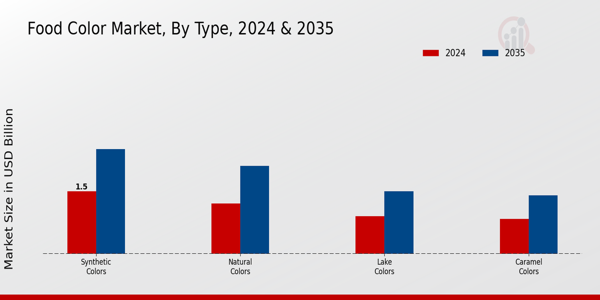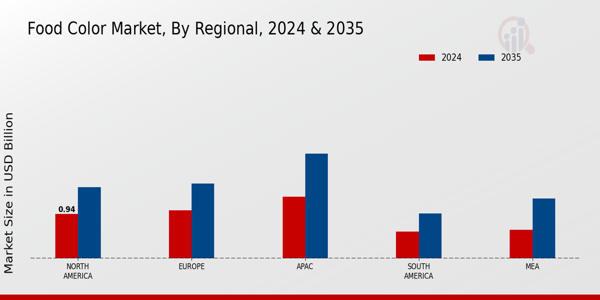Global Food Color Market Overview
As per MRFR analysis, the Food Color Market Size was estimated at 4.23 (USD Billion) in 2023. The Food Color Market Industry is expected to grow from 4.44(USD Billion) in 2024 to 7.5 (USD Billion) by 2035. The Food Color Market CAGR (growth rate) is expected to be around 4.88% during the forecast period (2025 - 2035).
Key Food Color Market Trends Highlighted
The Food Color Market is witnessing significant growth driven by increasing consumer demand for natural food products and clean-label ingredients. A shift towards healthier eating habits and product transparency is fueling the popularity of natural colors derived from fruits, vegetables, and plants. This trend aligns with the global push for sustainability and environmental responsibility, encouraging manufacturers to seek natural alternatives over synthetic dyes. Innovation in extraction and processing techniques has improved the availability and application of these natural colors, further supporting this trend.
Opportunities are emerging as regulations on synthetic colors tighten in various regions, prompting food and beverage companies to reformulate products to comply with new standards.The increasing popularity of organic and plant-based options provides a profitable opportunity for businesses to invest in natural food colorings. As social media grows, along with self-awareness regarding health, brands that communicate their use of natural ingredients stand to strengthen customer loyalty and enjoy a larger share of the market. Customization and personalization have gained tremendous attention in the Food Color Market.
Brands are competing to create appealing products by developing new color combinations and adding to shifting consumer preferences. Moreover, the growing vegan and vegetarian diet trends are increasing the need for natural food colors as producers strive to enhance marketing targeted at these groups.
Such trends indicate a dynamic market landscape where companies must adapt to changing preferences while ensuring compliance with regulatory environments globally.

Source: Primary Research, Secondary Research, MRFR Database and Analyst Review
Food Color Market Drivers
Increasing Demand for Natural Food Colors
The Food Color Market Industry is experiencing a significant shift towards natural food colors, driven by consumer demand for healthier and more organic food products. According to a report by the European Food Safety Authority (EFSA), 73% of consumers prefer natural over synthetic food colors, leading to a surge in the use of natural colorants in food and beverage products. This trend aligns with the global health initiatives raised by organizations such as the World Health Organization (WHO), which emphasizes the need to reduce artificial additives in food.As more companies like Nestle and Unilever have committed to reformulating their products to include natural ingredients, the demand for natural food colors is expected to continue to grow, significantly impacting the Food Color Market Industry. This increasing consumer preference for clean-label products is projected to contribute to the overall growth of the market as more manufacturers seek to meet this demand through natural coloring alternatives.
Expansion of the Food and Beverage Sector
The continuous growth of the global food and beverage sector plays a crucial role in driving the Food Color Market Industry. The Food and Agriculture Organization (FAO) reported that the global food industry is expected to reach over 10 trillion USD by 2025. This expansion is fueling innovations in product offerings, including ready-to-eat meals, snacks, and beverages, which increasingly require vibrant colors to attract consumers. Major brands, including Coca-Cola and PepsiCo, are heavily investing in product development to enhance visual appeal, thus increasing the demand for food colorants within the industry.The expanding food and beverage sector is anticipated to significantly influence the market's trajectory as manufacturers seek advanced coloring solutions to differentiate their products in a competitive landscape.
Regulatory Changes Favoring Natural Ingredients
Government regulatory bodies across various regions are implementing stricter regulations on synthetic food additives, which is significantly impacting the Food Color Market Industry. For instance, in the European Union, regulations outlined by the European Commission aim to limit the use of certain artificial food colors due to health concerns among consumers. The European Food Safety Authority (EFSA) has also recommended continuous monitoring of synthetic colors, leading manufacturers to explore natural alternatives.This regulatory environment is especially pertinent, as companies like McDonald's and Kraft Heinz have pledged to eliminate certain artificial dyes from their products to comply with health standards and consumer preferences. The response from regulatory bodies to promote safer food products reinforces the shift towards natural colors, providing a substantial growth opportunity for the Food Color Market.
Food Color Market Segment Insights
Food Color Market Type Insights
The Food Color Market is witnessing significant growth, with diverse types that cater to the rising consumer demand for visually appealing food products. In 2024, the overall market was valued at 4.44 USD Billion, indicating a robust marketplace that is likely to expand further. The segmentation of the Food Color Market by type is crucial for understanding consumer preferences and the dynamics at play. Natural Colors held a noteworthy position, valued at 1.2 USD Billion in 2024 and expected to grow to 2.1 USD Billion in 2035.This segment is largely driven by the increasing consumer inclination toward healthier, organic options, which contributes to its significant appeal.
Synthetic Colors were valued at 1.5 USD Billion in 2024 and are anticipated to expand to 2.5 USD Billion by 2035, reflecting a strong market presence as they are widely used in various industries for their vibrancy and cost-effectiveness. However, the preference for natural ingredients is fostering growth in the Natural Colors segment, which is expected to witness the majority holding in the overarching market trends.Caramel Colors were valued at 0.84 USD Billion in 2024 and are expected to reach 1.4 USD Billion by 2035; they find their significance primarily in the beverage industry, particularly in soft drinks and spirits, thus emphasizing their important role in food and beverage formulation.
Similarly, Lake Colors, which started at 0.9 USD Billion in 2024 and is expected to rise to 1.5 USD Billion by 2035, serves as an essential component due to their stability in various applications, particularly fatty and oily products. This stability fosters their use in numerous applications, thereby supporting market growth.Overall, the classification of the Food Color Market into these essential types accentuates how various components complement one another to fulfill consumer demand and industry standards while also highlighting the evolving trend toward natural alternatives amid the traditional reliance on synthetic colorings.
The increase in market valuation across distinct types reveals a competitive arena where businesses are diversifying their offerings to capitalize on evolving consumer preferences, with natural products gaining traction as sustainability becomes a more significant priority for manufacturers and consumers alike.

Source: Primary Research, Secondary Research, MRFR Database and Analyst Review
Food Color Market Application Insights
The Application segment of the Food Color Market plays a crucial role in driving the overall market dynamics. As of 2024, the market was valued at 4.44 USD Billion, reflecting the increasing demand across various applications. The Food and Beverages segment dominates this landscape, leveraging color additives to enhance the visual appeal and flavor of products, which strongly influences consumer purchasing behavior. Cosmetics and Personal Care also hold significant importance, as natural and synthetic colorants are often utilized to improve the aesthetic attributes of beauty products.In the Pharmaceuticals sector, colors are integral to branding and differentiation, ensuring compliance with rigorous health regulations.
Nutraceuticals are increasingly adopting vibrant food colors to highlight their health benefits, encouraging consumer confidence and choice. The market is witnessing growth driven by trends toward natural colors and clean labeling, with consumers becoming more health-conscious and seeking transparency in ingredients. However, challenges like stringent regulatory frameworks and potential adverse health effects related to synthetic colors remain prevalent.Nevertheless, the Food Color Market continues to expand, offering opportunities for innovation and development to meet evolving consumer preferences across the globe.
Food Color Market Formulation Insights
The Food Color Market, focusing on the formulation segment, has shown considerable growth as it caters to the diverse needs of the food industry. In 2024, the overall market was valued at 4.44 USD Billion, highlighting the crucial role that food colors play in enhancing the visual appeal of food products. Within this segment, the formulation types such as liquid, powder, and gel serve essential functions. Liquid food colors dominate due to their versatility and ease of use in various applications, including beverages and baked goods.Powdered colors offer a concentrated form that is preferred in dry mixes, while gel colors provide robust options for confections and icing. The market growth can be attributed to rising consumer demand for natural and synthetic colors, with a growing inclination towards food products that are visually appealing and of high quality. The market is propelled by trends such as clean-label products and natural food colorants. However, challenges such as regulatory restrictions on certain artificial colors may impact growth. The Food Color Market data supports the need for innovation to address these challenges and capitalize on emerging opportunities in health-conscious consumer preferences.
Food Color Market Source Insights
The Food Color Market is witnessing significant growth, particularly due to the diverse sources of food colors. As of 2024, the market's valuation stood at 4.44 USD Billion, reflecting a robust demand for vibrant food products. The segmentation of the market source includes Plant-Based, Animal-Based, and Mineral-Based food colorants, each playing a crucial role in shaping market dynamics. Plant-Based colors continue to dominate the landscape as consumers lean towards natural and organic products, spurred by a growing awareness of health and environmental sustainability.Animal-Based colors, though less in demand compared to plant-derived options, still hold importance in niche markets such as gourmet and traditional food segments.
Mineral-Based colors, on the other hand, are gaining traction due to their stability and safety in various applications. These sources not only cater to consumer preferences but also comply with regulatory standards, making them significant for manufacturers. Overall, the trends in the Food Color Market reveal a shift towards natural sources, spurred by changing consumer behaviors and the food industry's ongoing innovation toward cleaner-label products, further driving market growth.
Food Color Market Regional Insights
The Food Color Market has shown considerable potential across different regions, with a total market value of 4.44 USD Billion in 2024, expected to grow significantly by 2035. North America held a prominent position, valued at 0.939 USD Billion in 2024, anticipating an increase to 1.5 USD Billion by 2035, driven by the region's advanced food and beverage industry. Europe followed closely with a valuation of 1.02 USD Billion in 2024, projected to reach 1.579 USD Billion in 2035, benefiting from strong consumer preferences for natural food colors and stringent regulatory frameworks.
The Asia-Pacific (APAC) region dominated the market, achieving a valuation of 1.306 USD Billion in 2024, which is expected to climb to 2.211 USD Billion by 2035, largely attributed to its expanding food processing sector and increasing demand for colored products. South America and the Middle East and Africa (MEA), though smaller in market size at values of 0.571 USD Billion and 0.604 USD Billion, respectively, in 2024, are witnessing growth fueled by rising consumer awareness and changing dietary preferences with estimates of 0.947 USD Billion and 1.263 USD Billion by 2035.Each region plays a vital role in shaping the dynamics of the Food Color Market, highlighting diverse opportunities and the continuous evolution of food color trends in response to local consumer demands.

Source: Primary Research, Secondary Research, MRFR Database and Analyst Review
Food Color Market Key Players and Competitive Insights
The Food Color Market is characterized by a diverse and competitive landscape, driven by a growing demand for natural food colorants and regulatory changes across different regions. As consumers increasingly seek clean-label products, companies are compelled to innovate and expand their offerings to cater to this trend. Various manufacturers are utilizing advanced technologies and sourcing methods to produce an array of food color solutions, including synthetic, natural, and organic options. The market dynamics are influenced by factors such as consumer preferences, technological advancements, and the competitive strategies adopted by key players, thereby enhancing the overall market potential.
This competition propels companies to continuously assess their supply chains, pricing strategies, and product innovations to stay relevant in a rapidly evolving marketplace. Naturex stands out in the Food Color Market with a robust portfolio of natural color solutions derived from plant-based sources, essential for meeting consumer demand for healthier and cleaner food options. The company leverages its expertise in natural ingredient extraction to formulate diverse colorants that cater to various segments, including beverages, dairy, and snack foods. Naturex’s strengths lie in its innovative approach to product development and its dedicated research and development endeavors, which enhance its ability to introduce high-quality, sustainable color solutions. The company's extensive global distribution network allows it to effectively penetrate different geographic markets, ensuring it capitalizes on emerging trends in the health and wellness sector.
Additionally, Naturex's commitment to sustainability and transparency resonates with the evolving preferences of consumers, further solidifying its competitive position in the market.Colorcon is another prominent player in the Food Color Market, known for its comprehensive range of products that include colorants and customized excipients specifically designed for the food industry. The company’s strengths are evident in its ability to offer innovative solutions tailored to meet the specific requirements of food manufacturers. Colorcon emphasizes research and development to enhance its product offerings, ensuring they align with global regulatory standards while maximizing performance and stability in food applications.
The company's strategic market presence is fortified by collaborations and partnerships that extend its reach into various international markets. Through mergers and acquisitions, Colorcon has successfully integrated complementary technologies which enable them to enhance their capabilities in developing advanced coloring solutions. This emphasis on expanding its product line and strategic initiatives positions Colorcon as a competitive force within the Food Color Market, fostering consistent growth and adaptation to the changing market environment.
Key Companies in the Food Color Market Include:
- Naturex
- Colorcon
- Chr. Hansen
- Cargill
- Sensient Technologies
- ADM
- GNT Group
- Univar Solutions
- Eckert and Ziegler
- Allied Biotech
- BASF
- Tate and Lyle
- Funkin
- Kalsec
Food Color Market Industry Developments
The Food Color Market has seen several significant developments recently. In July 2023, Cargill announced a strategic partnership with Kalsec to expand the natural color offerings in their product line, enhancing their competitive positioning. Additionally, in June 2023, Chr. Hansen secured a new patent for a natural color extract derived from plants aimed at meeting the increased demand for clean-label products.
Naturex, a part of Givaudan, has also reported growth in product innovation, particularly in plant-based colors, catering to consumer preferences for healthier options. The market is witnessing a surge in demand, fueled by the increasing consumer inclination towards natural and organic food colors. As for mergers and acquisitions, in August 2022, ADM acquired a leading European natural colors company to broaden its portfolio in the food and beverage sector, which was widely discussed in industry circles.
Global regulatory bodies are now also adopting stricter guidelines regarding synthetic color additives, further pushing companies like Sensient Technologies and GNT Group to enhance their focus on natural alternatives. Overall, these developments reflect a dynamic shift in the Food Color Market driven by consumer preferences, regulatory changes, and strategic partnerships.
Food Color Market Segmentation Insights
-
Food Color Market Type Outlook
- Natural Colors
- Synthetic Colors
- Caramel Colors
- Lake Colors
-
Food Color Market Application Outlook
- FoodBeverages
- CosmeticsPersonal Care
- Pharmaceuticals
- Nutraceuticals
-
Food Color Market Formulation Outlook
-
Food Color Market Source Outlook
- Plant-Based
- Animal-Based
- Mineral-Based
-
Food Color Market Regional Outlook
- North America
- Europe
- South America
- Asia Pacific
- Middle East and Africa
| Report Attribute/Metric Source: |
Details |
| MARKET SIZE 2023 |
4.23(USD Billion) |
| MARKET SIZE 2024 |
4.44(USD Billion) |
| MARKET SIZE 2035 |
7.5(USD Billion) |
| COMPOUND ANNUAL GROWTH RATE (CAGR) |
4.88% (2025 - 2035) |
| REPORT COVERAGE |
Revenue Forecast, Competitive Landscape, Growth Factors, and Trends |
| BASE YEAR |
2024 |
| MARKET FORECAST PERIOD |
2025 - 2035 |
| HISTORICAL DATA |
2019 - 2024 |
| MARKET FORECAST UNITS |
USD Billion |
| KEY COMPANIES PROFILED |
Naturex, Colorcon, Chr. Hansen, Cargill, Sensient Technologies, ADM, GNT Group, Univar Solutions, Eckert and Ziegler, Allied Biotech, BASF, Tate and Lyle, Funkin, Kalsec |
| SEGMENTS COVERED |
Type, Application, Formulation, Source, Regional |
| KEY MARKET OPPORTUNITIES |
Natural food color demand surge, Clean label products trend, Expansion in developing economies, Innovative application in beverages, Health-conscious consumer preferences |
| KEY MARKET DYNAMICS |
Increasing demand for natural colors, Stringent regulatory standards, Growing health consciousness among consumers, Expansion of food and beverage industry, Technological advancements in color production |
| COUNTRIES COVERED |
North America, Europe, APAC, South America, MEA |
Food Color Market Highlights:
Frequently Asked Questions (FAQ) :
The Global Food Color Market is expected to be valued at 4.44 USD Billion in 2024.
By 2035, the Global Food Color Market is projected to reach a value of 7.5 USD Billion.
The Global Food Color Market is expected to have a CAGR of 4.88% from 2025 to 2035.
The APAC region is projected to reach a market value of 2.211 USD Billion by 2035.
Natural Colors are valued at 1.2 USD Billion in the Global Food Color Market for the year 2024.
Key players include Naturex, Cargill, Chr. Hansen, and Sensient Technologies among others.
The market value for Synthetic Colors is expected to be 2.5 USD Billion by 2035.
In North America, the Global Food Color Market is valued at 0.939 USD Billion in 2024.
The growth is driven by increasing demand for natural food colors and the expanding food and beverage industry.
The market for Lake Colors is expected to be valued at 1.5 USD Billion by 2035.

















